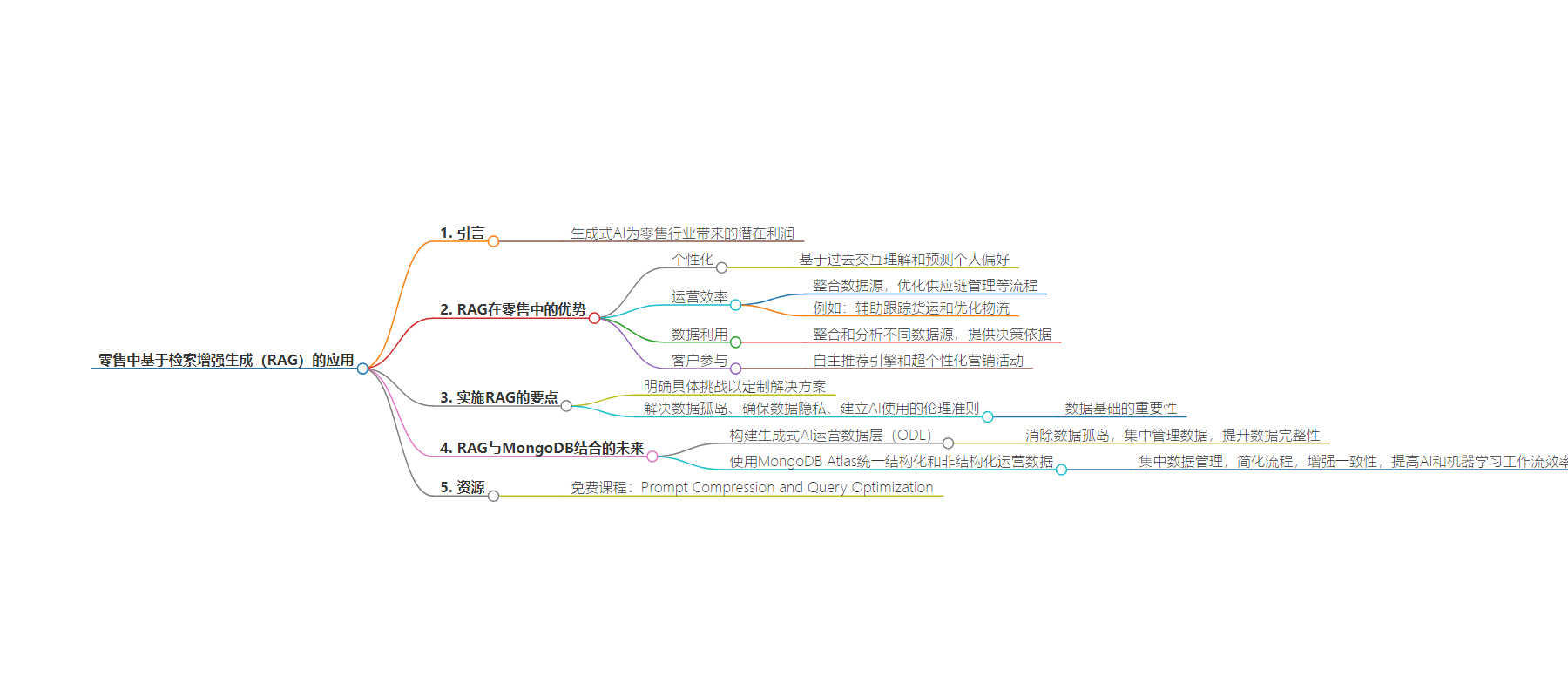包阅导读总结
1. 关键词:Retail、RAG、AI、Personalization、Operational efficiency
2. 总结:本文探讨了在零售领域中,RAG 这一人工智能应用的优势,包括个性化、运营效率提升等,强调其整合数据、增强客户体验的作用,同时指出需解决数据问题,借助如 MongoDB 等实现数据集成和优化。
3. 主要内容:
– 零售领域中科技创新重要,生成式 AI 潜力大,RAG 是有前景的发展
– RAG 对零售商的优势
– 实现个性化客户体验
– 提高运营效率,如优化供应链
– 充分利用大数据做决策
– 促进客户参与
– 应用 RAG 面临的挑战
– 需解决数据孤岛、隐私和伦理问题
– 数据基础要扎实
– 借助 RAG 和 MongoDB 迎接零售未来
– 建立通用 AI 运营数据层,消除数据孤岛
– 使用 MongoDB Atlas 统一数据,提供灵活架构
– 提及获取更多 RAG 零售资源的途径
思维导图:
文章地址:https://www.mongodb.com/blog/post/enhancing-retail-retrieval-augmented-generation-rag
文章来源:mongodb.com
作者:Prashant Juttukonda
发布时间:2024/7/31 13:58
语言:英文
总字数:782字
预计阅读时间:4分钟
评分:91分
标签:零售,人工智能,RAG,个性化,运营效率
以下为原文内容
本内容来源于用户推荐转载,旨在分享知识与观点,如有侵权请联系删除 联系邮箱 media@ilingban.com
In the rapidly evolving retail landscape, tech innovations are reshaping how businesses operate and interact with customers. Generative AI could add up to $275 billion of profit to the apparel, fashion, and luxury sectors’ by 2028, according to McKinsey analysis. One of the most promising developments in this realm is retrieval-augmented generation (RAG), a powerful application of artificial intelligence (AI) that combines the strength of data retrieval with generative capabilities to supercharge retail enterprises.
RAG offers compelling advantages specifically tailored for retailers looking to enhance their operations and customer engagement from personalization to enhanced efficiency. Let’s delve into how RAG is revolutionizing the retail sector.
Check out our AI resource page to learn more about building AI-powered apps with MongoDB.
Why RAG in retail
Imagine a customer walks into your store, and based on their previous opt-in online interactions, your technology recognizes their preferences and seamlessly guides them through a personalized service—a feat made possible by RAG. Central to RAG’s effectiveness is its ability to integrate and analyze diverse data sources scattered across data warehouses. This integration enables retailers to gain comprehensive insights into their business performance, understand consumer behavior patterns, and make data-driven decisions swiftly. Below are some of the compelling advantages that RAG can offer:
-
Personalization: RAG enables retailers to deliver highly personalized customer experiences by leveraging AI to understand and predict individual preferences based on past interactions.
-
Operational efficiency: By integrating diverse data sources and optimizing processes like supply chain management, RAG helps retailers streamline operations, reduce costs, and improve overall efficiency. For example, RAG aids in tracking shipments and optimizing logistics—a traditional pain point in the industry.
-
Data utilization: It allows retailers to harness the power of big data by integrating and analyzing disparate data sources, providing actionable insights for informed decision-making.
-
Customer engagement: RAG facilitates proactive customer engagement strategies through features like autonomous recommendation engines and hyper-personalized marketing campaigns, thereby increasing customer satisfaction and loyalty.
In essence, RAG empowers retailers to harness AI’s full potential to deliver superior customer experiences, optimize operations, and maintain a competitive edge in the dynamic retail landscape. But without a clear roadmap, even the most sophisticated AI solutions can falter. By pinpointing specific challenges—such as optimizing inventory management or enhancing customer service—retailers can leverage RAG to tailor solutions that deliver measurable business outcomes.
Despite its transformative potential, retailers must first be AI-ready and able to integrate it in a way that enhances operational efficiency without overwhelming existing systems. To achieve this, retailers need to address data silos, ensure data privacy, and establish robust ethical guidelines for AI use. According to a Workday Global Survey, only 4% of respondents said their data is fully accessible, and 59% say their enterprise data is somewhat or completely siloed. Without a solid data foundation, retailers will struggle to achieve the benefits they are looking for from AI.
Embracing the future of retail with RAG and MongoDB
By harnessing the power of data integration, precise use case definition, and cutting-edge AI technologies like RAG, retail enterprises can not only streamline operations but also elevate customer experiences to unprecedented levels of personalization and efficiency.
Building a gen AI operational data layer (ODL) enables retailers to make the most of their AI-enabled applications. A data layer is an architectural pattern that centrally integrates and organizes siloed enterprise data, making it available to consuming applications. As shown below in Figure 1, pulling data into a single database eliminates data silos, centralizes data management, and improves data integrity.
Using MongoDB Atlas to unify structured and unstructured operational data offers a cohesive solution by centralizing all data management in a scalable, cloud-based platform. This unification simplifies data management, enhances data consistency, and improves the efficiency of AI and machine learning workflows by providing a single source of truth. With a flexible data schema, retailers can accommodate any data structure, format, or source—which is critical for the 80% of real-world data that is unstructured.
As AI continues to evolve, the retail industry is poised to see rapid advancements, driven by the innovative use of technologies like RAG. The future of retail lies in seamlessly integrating data and AI to create smarter, more responsive business models.
If you would like to learn more about RAG for Retail, visit the following resources:
Add vector search to your arsenal for more accurate and cost-efficient RAG applications by enrolling in the MongoDB and DeepLearning.AI course “Prompt Compression and Query Optimization” for free today.
